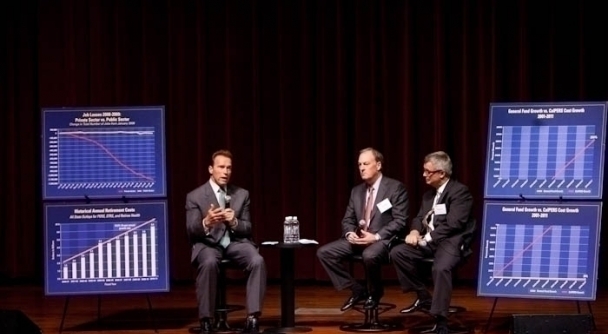A Legacy of Lower Taxes

In the seven years of his administration, Governor Schwarzenegger’s reform policies have saved taxpayers more than $14 billion—even taking into account the temporary revenue measures enacted to address the budget deficits resulting from the worst recession since the 1930s.
November 17, 2003 On his first day in office, Governor Schwarzenegger kept a campaign promise by repealing the car tax, returning $4 billion to the people of California. This major tax cut has saved California taxpayers more than $33 billion dollars over the last seven years and will continue to save taxpayers nearly $5 billion each year into the future.
The 2008–2009 Budget Governor Schwarzenegger negotiated permanent tax reform long sought by California businesses that will reduce business taxes by approximately $1 billion each year:
• Unitary Group Reform. The Governor made tax credits for businesses more valuable as part of the Unitary Group reform. Before this reform, a tax credit could only be used to offset the tax liability of the company that created it. Now the credit can be used to offset the liability of the parent and affiliated company, and California’s businesses are saving $300 million each year as a result.
• Net Operating Loss (NOL) Suspension and Carryback. This important reform conforms California’s NOL to federal law beginning in 2011. As a result, companies can now use the “net operating losses” from a prior year to reduce their tax liability. This change allows them to keep the losses for a longer time, giving them more time to use any losses. Previously the losses could only be used to offset a future liability. In exchange for this permanent tax reform, the NOL was temporarily suspended for two years as part of a revenue agreement to eliminate the budget deficit.
The 2009–2010 Budget
• Single Sales Factor. As a result of this reform, the State of California has changed how it assesses taxes on business. Previously, the tax system effectively taxed a company more because it does business here and employs people here. As a result of the Governor’s 2009–2010 budget, the state is now allowing firms to elect to use a formula that attributes profits to this state based entirely on sales in the state. This reform will save California businesses $900 million each year when fully implemented.
• Small Business Hiring Credit. California is offering a “new hire” tax credit to reward California businesses that create new California jobs now, when we need it most. In 2009 and 2010, California employers that began the year with twenty or fewer employees will be able to claim a $3,000 income tax credit for each new, full-time employee they hire. This reform will save small businesses $330 million in 2009–2010 and help create thousands of jobs.
• Film and Television Tax Credit. As part of a targeted economic stimulus package to increase film and television production in California, the Governor enacted a tax credit program in 2009 authorizing the California Film Commission to allocate $100 million in tax credits each fiscal year (or up to $200 million in its first year of operation to eligible productions through fiscal year 2013–2014).
March 24, 2010 Building on his commitment to clean technology growth in California, Governor Schwarzenegger signed SB 71, creating a sales tax exemption for the purchase of green tech manufacturing equipment in California. This tax exemption was a part of the Governor’s California Jobs Initiative, a legislative package that will create or retain at least 100,000 jobs.
May 25, 2010 Governor Schwarzenegger signed the home buyers’ tax credit, providing up to $10,000 to Californians who are buying their first home or purchasing a brand new home. This was a re-authorization of a $10,000 tax credit included in the 2009 budget deal. This legislation, part of the Governor’s larger California Jobs Initiative, is playing a key role in getting our economy moving again by encouraging home ownership and stimulating job creation.
